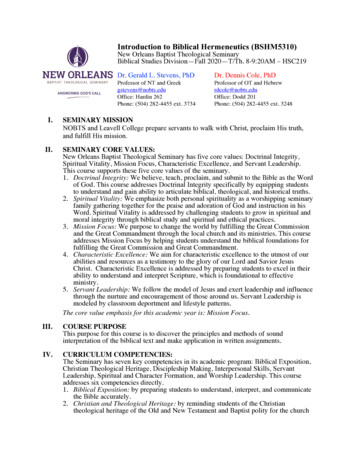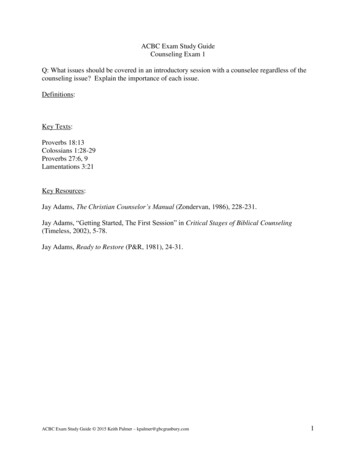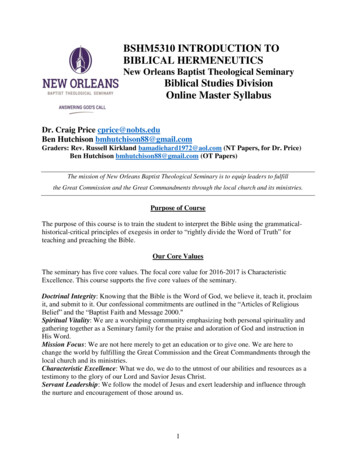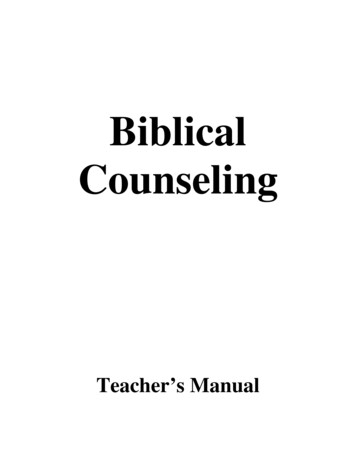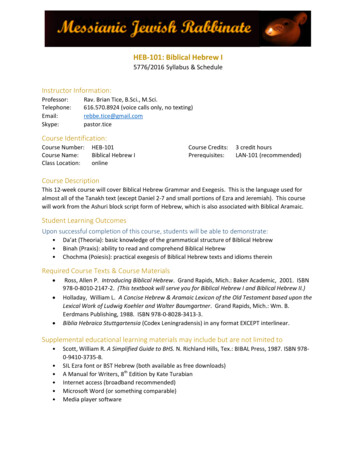
Transcription
QUICK REFERENCE GUIDE FOR BIBLICAL GREEKTRENT HUNTER
CONTENTSINTRODUCTION1. Introduction2. Features3. Definitions4. Signs and Sounds1234NOUN SYSTEM5. Noun Endings & Articles6. Prepositions7. Adjectives8. Pronouns6789VERB SYSTEM9. Verbal Roots10. Indicative Mood11. Subjunctive Mood12. Imperative Mood13. Mi Verbs14. Participles15. Infinitives16. Forms of eimiGraphical GreekCopyright 2011 by Trent Hunter. All rights reserved. Cover Design: Guillermo OchoaPlease do not freely share this eBook.1213141516171819
INTRODUCTIONGreek is tough.It is tough to learn and tough to keep. After two years of biblical Greek in college, I was eager to usethe New Testament’s original language in my teaching and preaching ministry. God’s people needGod’s Word, and I had invested time and treasure in this tool in order to bring it to them withaccuracy and clarity.But that’s not what I did. I was a new husband. And I was a new youth pastor. There was much tolearn. For the busyness of life and, no doubt, a lack of discipline, Greek became, once again, aforeign language. I found no encouragement in my 300-page Greek grammar or in two inches ofclass notes. Both stayed on the shelf. So did my Greek New Testament. And that’s the story ofcountless well-meaning former students of biblical Greek.Thankfully, seminary provided another shot at learning the language. Determined to keep what I washaving to relearn, I created a series of one-page study guides for personal reference. I workedthrough the grammar and weighed the relative importance of certain points. I considered how toarrange the critical material visually, simply, and memorably. As I developed these charts, Idiscovered that I was not alone in being helped by a resource like this. So, what began as a personalproject is now this reference guide.Graphical Greek does not replace a standard biblical Greek grammar, but neither is this just a severalpage list of word forms and rules in black and white. Graphical Greek really is something in between.By visually organizing the most important points of Greek grammar, Graphical Greek helps teachersteach, students learn, and pastors use the New Testament’s original language.Greek is tough. But, of course, it is worth the effort. The church needs the Word. After all, “man doesnot live by bread alone, but by every word that comes from the mouth of God” (Luke 4:4).—Trent Hunter1
2INTRODUCTIONFEATURESNeed-to-Know Content for each major division ofgrammar compiled into a single page.Colors are used throughout to indicate case for thenoun system and tense for the verb system.Formation Notes and Function Notes summarize theneed-to-know morphological and syntacticalinformation.Formation Funnels show how verbs are formed byprogressively displaying grammatical information.Formation Rule Bars are found at the top of verbfunnels to indicate the various parts of a verb and therules that govern each of those parts.Meaning Keys visually represent the meaningindicated by a verbal ending given its tense.
NOUN SYSTEM6ENDINGS AND ARTICLES3CASE TE avtw:ntoi:Vtav“the”Formation Notes Declensions:1. Stems ending in a, h 1st declension.2. Stems ending in o 2nd declension.3. Stems ending in a consonant 3rd declension. Similarities:1. All nominative and accusative neuters areidentical.2. Almost all nominative and accusative neuterplurals end in a.3. All datives share an “i” which subscripts in thesingular if possible.4. All genitive and dative neuters are identical totheir masculine counterparts. Changes:1. Vowels often change length (“ablaut”).Contraction: when two vowels meet to form adiphthong.Compensatory lengthening: when a vowellengthens to compensate for the loss of a letter.2. Square of stops:p b f s yk g c s xt d q s s3. The t drops off at the end of a word.t & n drop off when followed by a sigma.Consonants that can end a noun are n, p, ς (y, x).*This is a modification of Bill Mounce’s seven noun rules.Function Notes Case functions: Endings, not word order, determinemeaning.Nominative: Subject, predicate nominative.Genitive: Possession (“of”), object of preposition,direct object, separation (“from”).Dative: Indirect object (“to/for”), object ofpreposition, direct object, instrumental (“by/with”),locative (“in/at”).Accusative: Direct object of the verb, object ofpreposition, subject of infinitive. Articles: An article will always agree in case, number,and gender with the noun it modifies. If the definitearticle is absent, the indefinite article, “a,” may beinserted before a noun if it makes better sense. Articlesbefore proper names (God, Paul) and abstract nouns(truth) may be omitted in translation.
With the Genitiveejpiv, ejp , ejf “on, over, when”katav“against”ajpov“(away) from”diav“through”ejk, ejx“from”ejxw“outside”e”wV“as far as, fore”parav“from”*periv“concerning, about”*uJpevr“in “behalf of”With the Dativeejn“in, on, among”suvn“with”parav“beside, in the presence”ejpiv, ejp , ejf “on the basis of, at”A connecting word that shows a relationship between two wordsVISUAL DIAGRAM OF aveijVajpovejpivejn*Not in visualejk,ejxdiave[wVkatavsuvnmetavejpivuJpovWith the ��to, with, toward”eijV“into, in, among”ejpiv, ejp , ejf “on, to, against”uJpov“under, below”parav“along side of”metav“after”*katav“according to”*diav“on account of”metavparavUSAGE KEYPREPOSITIONSparavNOUN SYSTEM7ejxw*This diagram is a memory aid, providing a visual representation of most prepositions and not just those prepositions whose meaning is spatial.Formation Notes The meaning of a preposition is determinedby the case of its object.Function Notes The word following a preposition is the “object of the preposition.” Preposition word Prepositional phrase. A prepositional phrasenswers the question, Who? Which? When? Where? An article followed by a prepositional phrase should generally betranslated as a relative clause: “who,” “which,” etc. Meanings: Prepositions with the genitive generally indicate motion awayfrom. Prepositions with the dative generally indicate rest. Prepositionswith the accusative generally indicate motion.
9VERB SYSTEM13INDICATIVE MOODA word that describes an action or a state of being that isFORMATION FUNNELFORMATION RULE BARAugment/ReduplicationTense Stem Tense FormativeAugment Rules: e j construct; h q; An augment indicates past time. Indicated below in black.Reduplication Rules: construct e 1construct; ej 2construct; p, k, t e f, c, q. Stems ending inl, m, n, r are “liquids.”Rules for both: Vowels lengthen; Diphthongs may lengthen and i subscripts.Compound Rules: Aug/redup stem; ejk ejxe; Vowels ending a prep usually drop.(Liquid) meneso/eUsually present time/past timeAlways future time(Liquid) emeinaPERSONAL no circumflex insome contracts*some lengtheningmenw: (Liq)*circumflex after liquids*some stem eteousi(n)nV-(n)menten [san]*with connecting vowelsVoiceMid/PassFFPfPrimarymaisai/h/taie[lusa (1A)*1SA has no endinge[labon (2A)e[meina (Liq)luvsomaiejlusavmhn (1A)menou:mai (Liq)ejgenovmhn (2A)*2SM s drops, a o wmeqasqentai*e(n)Perfect M/Plelumeqaso/ou sqentotoFINISHEDFORMS*1ST Person Singular Ending forms are notverb functions. Functions are indicatedin the Meaning Key.Aorist P / Future P(1) eluqh(2) egrafh(1) luqhso/e(2) apostalhso/eCHANGE RULESContracts (a,e,o)123*[aor pass]mhn Personal Endings o before m and n. e everywhere else. n/a for sign ending in vowel.Usually past timePersonPPF(1) leluka(2) gegonaUsually past timeSecondaryVerb MeaningPPerfect A(1) elusa(2) elabo/e*past time/augmentedVerb EndingMid/PassActiveConnecting Vowel“I will be loosed” “I was loosed”eluo/eluso/eMEANING KEYluvomai Stems ending withliquids receive new tenseformative in future & aorist.“I have loosed (for) myself”“I have been loosed”luo/eAorist A, M“I have loosed”Future A, M“I loosed / (for) myself”Present A, M/PImperfect A, M/PPrimaryluvw SIX TENSE FORMS“I will loose / (for) myself”“I was / am loosing”“I was / am loosing (for) myself”“I was / am being loosed” 123 Contract Connecting Vowel Contract:o o, o e, e o ou:; e e ei:; o/w w: (“o” sound wins);a e a,: e a h: (first wins); oei oi: Contract (a, e, o) Sign/Ending Lengthen:a , e hv ending; o wv endingIntervocalic σ: When a “s” gets forced between two vowels,because of inflection, it drops out. Vowels then contract (sai h).This does not apply for tense signs starting with s.Square of Stops σ:p b f s yk g c s xt d q s slevluka (1Pf)ejluvqhn (1A)kakamenkaV kateke(n) kasi(n)/kan*aspiration before qejgravfhn (2A)*q drops offgevgona (2Pf)levlumailuqhvsomai (1F)*aspiration before q:(p,b f; k,g c; t,d,q s)ajpostalhvsomai (2F)*q drops off
10 VERBSYSTEM14SUBJUNCTIVE MOODA word that describes an action or state of being that is potentialFORMATION FUNNELFORMATION RULE BARKey Preceding Wordsi{nai{na mhvo{pwV mhvwmen, wmeqaejavno}V a[no{pou a[no{tane{wVe{wV a[nouj mhv Unaugment“in order that, that ”“lest ”“lest ”“let us ”“if ”“whoever ”“wherever ”“whenever ”“until ”“until ”“emphatic negation ” No time, sono augment(aorist).Tense Stem Tense Formative Connecting Vowel Vowels lengthen: o w, e h. Below, Connecting Vowels areattached to Personal Endings Only presentand aorist.TENSE FORMSPresent A, M/PAorist A, MAorist Plu(1) lus(2) lab(1) luq(2) lab*Look out for i{na, ejavn, and a[n, e{wV*If no key word is present, translate with “may” or “might.”*If/then protasis/apodosisPERSONAL ENDINGSMEANING KEYPwh/Vh/AAPPwmenhtewsi(n)wmai wmeqah/hsqehtai wntaiAFINISHED i luswvmeqaluvh/luvhluvshluvhtailuvhtailuvshtai luvswntailuvshsqePersonal Endings All primary endingsdue to do no augment. Aorist passive takesactive endings.
VERB SYSTEM18INFINITIVESA verbal nounFORMATION FUNNELFORMATION RULE BARKey Preceding Word/Article Unaugment/Reduplication Tense Stem Tense Formative/Connecting Vowel MorphemeAnarthrous No augments, sinceno past time (aorist). Perfects have reduplication.Complementary Infinitive Never articulardei:“It is necessary to ”e{xestin“It is lawful to ”mevllw“I am about to ”duvnamai“I am able to ”a{rcomai“I am beginning to ”qevlw“I wish to ”keleuvw“I command to ”ojfeivlw“I ought to ”Resultw{ste“so that/with the result that ”Purpose (in order that/to)eijV tov, provV tov (art inf & prep)tou: ei\nai (gen art & inf)ei\nai (anarthrous inf) “in order that/to ”ArticularSubstantive Infinitive Usually articular,no key words“to is good”Articular Infinitive and Preposition Purpose/Result:diav tov“because”eijV tov, provV tov“in order that/to” Temporal:prov tou:“before”ejn tw/:“when/while”metav tov“after” ein, ai, nai, sqai. Only present,aorist, and sqaiFINISHED ilabh:naiFormation Notes Parse: tense, voice, “infinitive.” Always indeclinable (no case endings), but isviewed as neuter singular. When preceded by a definite article, thearticles are always neuter singular with casebeing determined by function. All forms end in ai, except present and 2aoractive. Irregular contracts in present active: alphacontracts form an instead of a/n. Omicroncontracts form ou:n instead of sqaiPerflelukevnaileluvsqaiFunction Notes No time significance, only aspect:Present Continuous; Aorist UndefinedPerfect Completed action with ongoing implications. Since nuances are near impossible to translate intoEnglish, the present (“to ”) will work for bothpresent and aorist. As a non-finite verbal form (not limited by a subject)it cannot have a subject. There is often a noun in theaccusative acting like a subject. Contextdistinguishes subject from direct object. Use mhv for negation (as with all non-indicativeverbs). 5 ways to translate: see key word/article.
Graphical Greek is a quick reference guide forbiblical Greek that consolidates and visuallyorganizes the crucial data found in a standardintroductory Greek grammar. Students and teacherswill find this reference guide helpful in the acquisitionand use of the New Testament’s original language.“Trent Hunter has written a helpful tool for thosestudying Greek. We know that learning a newlanguage is no easy task, and this work provideswonderful practical assistance to those who desire tostudy the New Testament in the original language.”THOMAS R. SCHREINERProfessor of New Testament InterpretationThe Southern Baptist Theological SeminaryQUICK REFERENCE GUIDEFOR BIBLICAL GREEK“This is certainly something I wished I had had whenstudying Greek. This is an excellent resource!”JUSTIN TAYLORVice President of Editorial, CrosswayBlogger, Between Two WorldsTRENT HUNTER earned his B.A. from Moody BibleInstitute and his M.Div. from The Southern BaptistTheological Seminary. He currently serves as anExecutive Assistant at Desert Springs Church inAlbuquerque, New Mexico.
learn. For the busyness of life and, no doubt, a lack of discipline, Greek became, once again, a foreign language. I found no encouragement in my 300-page Greek grammar or in two inches of class notes. Both stayed on the shelf. So did my Greek New Testament. And that’s the story of countless well-me




